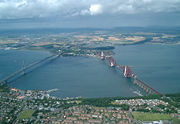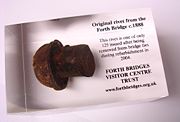Forth Railway Bridge
2008/9 Schools Wikipedia Selection. Related subjects: Engineering; Railway transport
| Forth Bridge | |
|---|---|
 |
|
| Carries | Rail traffic |
| Crosses | Firth of Forth |
| Locale | Edinburgh, Inchgarvie and Fife, Scotland |
| Maintained by | Balfour Beatty under contract to Network Rail |
| Design | Cantilever bridge |
| Longest span | 2 of 521.3 m (1710 ft) |
| Total length | 2,528.7 metres (8,296 ft) |
| Clearance below | 150 feet (46 m) |
| AADT | 190 - 200 trains per day |
| Opening date | March 4, 1890 |
| Coordinates | Coordinates: |
The Forth Bridge is a cantilever, railway bridge over the Firth of Forth in the east of Scotland, to the east of the Forth Road Bridge, and 14 km (9 miles) west of central Edinburgh. It is often called the "Forth Rail Bridge" to distinguish it from the Forth Road Bridge. The bridge connects Scotland's capital Edinburgh with the Kingdom of Fife, and acts as a major artery connecting the north-east and south-east of the country. Described as "the one internationally recognised Scottish landmark", it may be nominated by the British government as a UNESCO World Heritage Site. The bridge and its associated railway infrastructure is owned by Network Rail Infrastructure Limited.
History
Construction of an earlier bridge, designed by Sir Thomas Bouch, got as far as the laying of the foundation stone, but was stopped after the failure of another of his works, the Tay Bridge. Bouch had proposed a suspension bridge but the public inquiry into the Tay bridge disaster showed that he had under-designed the structure and mistakenly used cast iron, which weakened the entire structure. On Bouch's death the project was handed over to Sir John Fowler and Sir Benjamin Baker, who designed a structure that was built by Sir William Arrol & Co. between 1883 and 1890. It was built in steel alone, being the first bridge to use that material. Baker - "one of the most remarkable civil engineers Britain ever produced" - and his colleague Allan Stewart received the major credit for design and overseeing construction work.
Construction
The bridge is, even today, regarded as an engineering marvel. It is 2.5 km (1.5 miles) in length, and the double track is elevated 46 m (approx. 150 ft) above high tide. It consists of two main spans of 1,710 ft (520 m), two side spans of 675 ft, 15 approach spans of 168 ft (51 m), and five of 25 ft (7.6 m). Each main span comprises two 680 ft (210 m) cantilever arms supporting a central 350 ft (110 m) span girder bridge. The three great four-tower cantilever structures are 340 ft (104 m) tall, each 70 ft (21 m) diameter foot resting on a separate foundation. The southern group of foundations had to be constructed as caissons under compressed air, to a depth of 90 ft (27 m). At its peak, approximately 4,600 workers were employed in its construction. Initially, it was recorded that 57 lives were lost; however, after extensive research by local historians, the figure has been revised upwards to 98. Eight men were saved by boats positioned in the river under the working areas.
Hundreds more were left crippled by serious accidents, and one log book of accidents and sickness had 26,000 entries. In 2005, a project was set up by the Queensferry History Group to establish a memorial to those workers who died during the bridge's construction. In North Queensferry, a decision was also made to set up memorial benches to commemorate those who died during the construction of both the rail and the road bridges, and to seek support for this project from Fife Council.
More than 55,000 tons of steel were used, as well as 18,122 m³ of granite and over eight million rivets. The bridge was opened on March 4, 1890 by the Prince of Wales, later King Edward VII, who drove home the last rivet, which was gold plated and suitably inscribed. A contemporary materials analysis of the bridge, circa 2002, found that the steel in the bridge is of good quality, with little variation.
The use of a cantilever in bridge design was not a new idea, but the scale of Baker's undertaking was a real pioneering effort, afterwards extensively followed in different parts of the world. Much of the work done was without precedent, including calculations for incidence of erection stresses, provisions made for reducing future maintenance costs, calculations for wind pressures made evident by the Tay Bridge disaster, the effect of temperature stresses on the structure, and so on.
Where possible, the bridge used natural features such as Inchgarvie, an island, the promontories on either side of the firth at this point, and also the high banks on either side.
The bridge has a speed limit of 50mph for passenger trains and 20mph for freight trains. The weight limit for any train on the bridge is 1,422 tonnes (1,442,000 kg) although this is waived for the frequent coal trains, provided two such trains do not simultaneously occupy the bridge. The route availability code is RA8, meaning any current UK locomotive can use the bridge, which was designed to accommodate the heavier steam locomotives.
Up to 190-200 trains per day crossed the bridge in 2006.
Maintaining the Forth Bridge
A structure like the Forth Bridge needs constant maintenance and the ancillary works for the bridge included not only a maintenance workshop and yard but a railway "colony" of some fifty houses at Dalmeny Station. The track on the bridge is of "waybeam" construction: 12 inch square baulks of timber 6 metres long are bolted into steel troughs in the bridge deck and the rails are fixed on top of these special sleepers known as waybeams. In 1992 the bridge was re-railed with standard BS113A rail(54 kg/m). Prior to 1992 the rails on the bridge were of a unique "Forth Bridge" Section.
Although modern trains put fewer stresses on the bridge than the earlier steam trains, the bridge needs constant maintenance, and this is currently undertaken by Balfour Beatty under contract to Network Rail.
"Painting the Forth Bridge" is a colloquial term for a never-ending task (a modern rendering of the myth of Sisyphus), coined on the erroneous belief that, at one time in the history of the bridge, repainting was required and commenced immediately upon completion of the previous repaint. According to a 2004 New Civil Engineer report on contemporary maintenance, such a practice never existed, although under British Rail management, and before, the bridge had a permanent maintenance crew.
A contemporary repainting of the bridge commenced with a contract award in 2002, for a schedule of work expected to continue until March 2009, involving the application of 20,000 m² of paint at a cost estimate of £13M a year. This new coat of paint is expected to have a life of at least 25 years. In 2008 the total cost was revised upwards to £180M, and projections for finishing the job to 2012.
In a report produced by JE Jacobs, Grant Thornton and Faber Maunsell in 2007 which reviewed the alternative options for a second road crossing, it was stated that the estimated working life of the Forth Rail Bridge was in excess of 100 years.
Competition
The Forth Road Bridge is another popular crossing of the Firth.
In 2007, in a two week trial jointly funded by SEStran and StageCoach, a passenger hovercraft ran between Kirkcaldy and Edinburgh. Video of landing at Edinburgh
The new Stirling-Alloa-Kincardine rail link under construction will divert coal trains from the bridge. Instead they will travel via Stirling to Longannet Power Station. With this, there is a possibility that freight restrictions will be lifted and the potential of increasing trains from 10 tph (trains per hour) to 12 tph.
Popular culture
- The bridge is featured prominently in a scene in Alfred Hitchcock's 1935 film The 39 Steps and even more so in the 1959 remake.
- The bridge long featured in posters advertising the soft drink Barr's Irn Bru, with the slogan: Made in Scotland, from girders
- The bridge was lit up red for BBC's Comic Relief in 2005
- A countdown clock to the millennium was placed on the bridge in 1998.
- The Bridge, a novel by Iain Banks, is mainly set on a fictionalised version of the bridge.
- In Alan Turing's most famous paper about artificial intelligence, one of the challenges put to the subject of an imagined Turing test is "Please write me a sonnet on the subject of the Forth Bridge". The test subject in Turing's paper answers, "Count me out on this one. I never could write poetry".
- The Kincaid Rail bridge in the video game Grand Theft Auto: San Andreas is based on this bridge. The designer, Rockstar North, is based in Edinburgh.
- The process of painting the bridge presumably inspired Tom Stoppard's radio play Albert's Bridge.
- Sebastien Foucan, a French freerunner, crawled along one of the highest points of the bridge, without a harness, for the Jump Britain documentary made by Channel 4.
- Linus points out the bridge from the airplane in the 1980 Peanuts film, Bon Voyage, Charlie Brown (And Don't Come Back!!) as they approached Heathrow Airport. The Forth Bridge is 273 nautical miles (506 km) north of Heathrow, but is generally visible on the approach to Edinburgh Airport.
- Robin Laing, a Scottish folk singer, recorded a song about the structure and Ben Baker entitled "The Forth Bridge"






